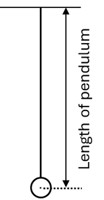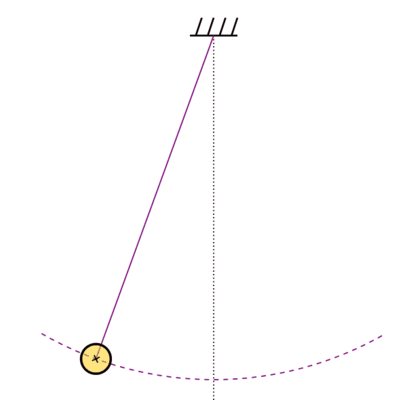Have you ever seen a big clock with a swinging pendulum and wondered what makes it tick so perfectly? In this activity you will find out what affects how fast or slow a pendulum swings. Is it the weight of the bob that matters, or is it something else – like the length of the string? By the end of this activity, you’ll have your own evidence-based answer!
Introduction
A simple pendulum is a system with a mass (bob) suspended by a light, inextensible string from a fixed support. It exhibits oscillatory motion, or a back-and-forth swinging motion, driven by gravity, making it a classic example of periodic motion. When displaced from its resting position, the pendulum swings back and forth, completing a full swing or oscillation each time it returns to its starting point.
Definition of Terms
-
Oscillation: An oscillation refers to one complete movement of the pendulum from its starting point to one extreme position, back to the other extreme, and then returning to the starting point.
-
Time period: The time period is the time taken for the pendulum to complete one full oscillation.
-
Amplitude: Amplitude is the maximum displacement of the pendulum bob from its equilibrium (rest) position during its motion. It represents how far the bob swings on either side of the equilibrium.
-
Center of mass: The center of mass of the pendulum is the point where its entire mass can be assumed to be concentrated for the purpose of analyzing its motion.
Activity
Requirements
Two objects of different masses (e.g., a small stone and a larger stone or metal washers), spring balance (to measure mass), about 50 cm of strong thread, stopwatch (or a phone with a timer), ruler or measuring tape, and a stand/hook/any fixed support to hang the pendulum from.
Procedure
-
Measure the mass of both objects using a spring balance and note them down.
-
Tie one object to one end of the thread and suspend it from a fixed point so it can swing freely. Measure the length of the pendulum from the suspension point to the center of the object. (The length of the pendulum is defined as the distance from the point where it is suspended to the center of mass of the object as shown in the figure).
 Image Credit: Kindle Education.
Image Credit: Kindle Education. -
Predict what you think will happen: will a heavier object swing slower or faster? Will a longer pendulum take more time to swing?
-
Pull the object slightly to one side and release it gently. Using a stopwatch, measure the time for 10 complete swings and divide this total time by 10 to get the time period of one swing. Write down your result.
-
Change the length of the thread and repeat the timing and calculation for the new length.
-
Replace the first object with the second object and repeat the above steps for the same lengths.
Observations
Mass 1 = _____
Mass 2 = _____
Number of oscillations (n) = _____
| Sr. No. | Length of pendulum | Time period for ‘n’ oscillation (Mass 1) |
Time period for one oscillation (Mass 1) |
Time period for ‘n’ oscillation (Mass 2) |
Time period for one oscillation (Mass 2) |
|---|---|---|---|---|---|
| 1. | 30 cm | ||||
| 2. | 40 cm | ||||
| 3. | 50 cm |
Reflect and Discuss
-
What does the time period of oscillation of a pendulum depend on?
-
Why do we measure the time taken for 10 oscillations and then divide by 10, instead of measuring just one swing directly? How does this improve your result?
-
Does the amplitude of the pendulum make any difference in the observations? What is more preferred while doing the experiment – less amplitude of more amplitude?
-
Imagine doing this experiment on the Moon, where gravity is weaker than on Earth. Would your pendulum swing faster, slower, or the same? Explain your reasoning.
-
In an ideal pendulum clock, only the length of the pendulum and gravity determine the period. What other real-world factors could still affect the accuracy of such a clock?

